Items
Tag
NMW
-
 Ladle Matilda Coxe Stevenson collected this black and white earthen ladle from the Zuni tribe of New Mexico. The solid symbols pictured throughout the bowl are believed to be clouds. Additionally, ladles served as intermediary vessels of varying shapes and sizes. They have been reported to aid in evenly dispersing water throughout gardens, to precisely transfer paint, and serve food.. It is likely that the symbolism present, in conjunction with the ladles use, is intended to promote precipitation that ideally will aid in the growth of the plants.
Ladle Matilda Coxe Stevenson collected this black and white earthen ladle from the Zuni tribe of New Mexico. The solid symbols pictured throughout the bowl are believed to be clouds. Additionally, ladles served as intermediary vessels of varying shapes and sizes. They have been reported to aid in evenly dispersing water throughout gardens, to precisely transfer paint, and serve food.. It is likely that the symbolism present, in conjunction with the ladles use, is intended to promote precipitation that ideally will aid in the growth of the plants. -
 Ladle This ceramic ladle, a shashokane, was acquired by Matilda Coxe Stevenson during her time among the Zuni in current day New Mexico. The large red numbers (here, 585) served as an original identification number for Stevenson during her anthropological expeditions. Ladles served as intermediary vessels of varying shapes and sizes. They have been reported to aid in evenly dispersing water throughout gardens, to precisely transfer paint, and serve food.
Ladle This ceramic ladle, a shashokane, was acquired by Matilda Coxe Stevenson during her time among the Zuni in current day New Mexico. The large red numbers (here, 585) served as an original identification number for Stevenson during her anthropological expeditions. Ladles served as intermediary vessels of varying shapes and sizes. They have been reported to aid in evenly dispersing water throughout gardens, to precisely transfer paint, and serve food. -
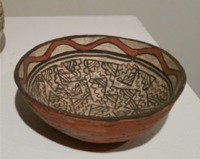 Food bowl This is a Zuni ceramic food bowl intricately decorated with stylistic patterns. The center interior is covered in mountains, with their bottoms meeting with rivers. The upper interior is lined with a border pattern which is understood to be translated as clear weather. In good condition,with little to no abrasions, we were able to better examine the imagery of the bowl and dissect the symbolism assigned to the piece. Based on the imagery, the meaning of the bowl is likely a design with a lighthearted, hopeful connotation, associated with a clear New Mexico landscape.
Food bowl This is a Zuni ceramic food bowl intricately decorated with stylistic patterns. The center interior is covered in mountains, with their bottoms meeting with rivers. The upper interior is lined with a border pattern which is understood to be translated as clear weather. In good condition,with little to no abrasions, we were able to better examine the imagery of the bowl and dissect the symbolism assigned to the piece. Based on the imagery, the meaning of the bowl is likely a design with a lighthearted, hopeful connotation, associated with a clear New Mexico landscape. -
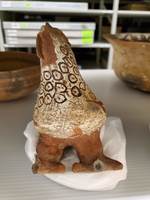 Chicken figurine This chicken effigy is a product of the Zuni tribe in New Mexico. Acquired by Matilda Coxe Stevenson, we have been able to determine it is in fact a chicken by the general shape, including its small upward tail, and dotted feathers. However, a thumb sized spout located on its back is unusual, but not unheard of among Stevenson’s other bird collections. This figurine has experienced some damages during its travels to the Smithsonian and then after being gifted to Lafayette College. Notably, the figurine is missing its outside toe on its right foot. While the damage is unfortunate, it has provided us with information, that would otherwise be challenging, or nearly impossible, to confirm, such as the use of black clay temper.
Chicken figurine This chicken effigy is a product of the Zuni tribe in New Mexico. Acquired by Matilda Coxe Stevenson, we have been able to determine it is in fact a chicken by the general shape, including its small upward tail, and dotted feathers. However, a thumb sized spout located on its back is unusual, but not unheard of among Stevenson’s other bird collections. This figurine has experienced some damages during its travels to the Smithsonian and then after being gifted to Lafayette College. Notably, the figurine is missing its outside toe on its right foot. While the damage is unfortunate, it has provided us with information, that would otherwise be challenging, or nearly impossible, to confirm, such as the use of black clay temper. -
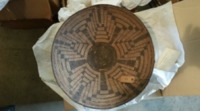 Basket This coiled basket tray was acquired by Mrs. Mary Manning Fletcher, published as Mrs. L.C. Fletcher, from the Pima tribe in Arizona. The Pima, also known as the Akimel O'odham or “River People” are renowned for their intricate weaves. The entire bowl is marked by one, large, woven, star shaped design.
Basket This coiled basket tray was acquired by Mrs. Mary Manning Fletcher, published as Mrs. L.C. Fletcher, from the Pima tribe in Arizona. The Pima, also known as the Akimel O'odham or “River People” are renowned for their intricate weaves. The entire bowl is marked by one, large, woven, star shaped design. -
Basket This, now flattened, basket was once used by the peoples of the Tlingit tribe in Alaska. Traveling as a Preysbeterian leader, Sheldon Jackson, made an effort to “civilize” the Indigenous peoples. Simultaneously, Jackson supplied trained medical professionals to isolated communities. During his time in Alaska, he collected Indigenous art and material culture, some of which he gave to Mrs. J.C. Kinney to be sold to help young Alaskan natives afford to build houses. It is likely that the Smithsonian acquired this basket from one of her stops during her traveling sale.
-
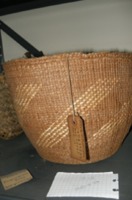 Basket This simply patterned large basket was collected by Mrs. Mary Manning Fletcher, more famously known as Mrs. L.C. Fletcher, from the Tlingit tribe. The basket is likely composed of spruce root, fern stem, and bear grass. Three different color strips are featured in its design: tan, yellow and red. The tan strips compose the majority of the basket. There are slanted vertical lines which are composed of alternating red and yellow segments. Fletcher was likely gifted it for a small price while conducting her anthropological work in Alaska before it made its way to the Smithsonian.
Basket This simply patterned large basket was collected by Mrs. Mary Manning Fletcher, more famously known as Mrs. L.C. Fletcher, from the Tlingit tribe. The basket is likely composed of spruce root, fern stem, and bear grass. Three different color strips are featured in its design: tan, yellow and red. The tan strips compose the majority of the basket. There are slanted vertical lines which are composed of alternating red and yellow segments. Fletcher was likely gifted it for a small price while conducting her anthropological work in Alaska before it made its way to the Smithsonian. -
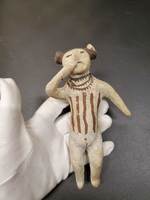 Doll figurine This ceramic Hopi doll figurine was collected by J.W. Fewkes in Arizona. She is painted using a white as a base coat and brown and auburn for details. We know she is female by the clear and deliberate slit running from front to back in between her legs. She has several small blushes and was likely used as a toy for young children.
Doll figurine This ceramic Hopi doll figurine was collected by J.W. Fewkes in Arizona. She is painted using a white as a base coat and brown and auburn for details. We know she is female by the clear and deliberate slit running from front to back in between her legs. She has several small blushes and was likely used as a toy for young children. -
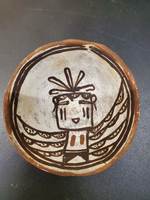 Ceremonial bowl: Kachina, Spirit Dancer Collected by Matilda Coxe Stevenson, this Hopi bowl was acquired in Arizona. This coil bowl has a painting of a Hopi spirit, similar to the mask designs of the Kachinas, filling its interior. There are notable characteristics, such as the paired vertical lines on the beings face, the head feathers and the wings which are generally associated with identifiable spirits. The underside of the bowl has two significant features as well: the original red identification numbers, 226, and a sizable blushing.
Ceremonial bowl: Kachina, Spirit Dancer Collected by Matilda Coxe Stevenson, this Hopi bowl was acquired in Arizona. This coil bowl has a painting of a Hopi spirit, similar to the mask designs of the Kachinas, filling its interior. There are notable characteristics, such as the paired vertical lines on the beings face, the head feathers and the wings which are generally associated with identifiable spirits. The underside of the bowl has two significant features as well: the original red identification numbers, 226, and a sizable blushing. -
 Tripodal cup The tall Chiriqui style tripodal cup was acquired in Panama. It was likely used as a vase, however, it is unclear whether it was a domestic or ceremonial item. If ceremonial, it was likely taken from burial grounds and brought to the Smithsonian as ethnographic artifacts.
Tripodal cup The tall Chiriqui style tripodal cup was acquired in Panama. It was likely used as a vase, however, it is unclear whether it was a domestic or ceremonial item. If ceremonial, it was likely taken from burial grounds and brought to the Smithsonian as ethnographic artifacts.